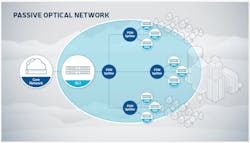Overcoming fiber broadband interoperability challenges with an open ONU approach
By Dan Gledhill / Harmonic
An Open ONU strategy for fiber broadband deployment — an approach that supports the use of any optical network unit (ONU) or optical network terminal (ONT) with an optical line terminal (OLT) — lets operators break free from vendor lock-in, accelerate deployment of high-speed broadband service, benefit from competitive ONU pricing and simplify network evolution.
Providing this interoperability presents several challenges for ONU and OLT vendors, but the benefits for operators ultimately result in a massive up-side for the industry.
PON evolution
The adoption of fiber for broadband service delivery is growing at a record pace in North America. According to a report from the Fiber Broadband Association, fiber broadband passed more than 78 million homes in 2023, an uptick of 13%. More than 51% of all primary homes in the U.S. now have access to fiber.
This surge in fiber broadband has sparked an evolution in passive optical network (PON) deployment, posing challenges for broadband service providers and operators as they strive to gain a competitive edge and grow revenue. Significant infrastructure upgrades and investments are needed as fiber networks transition to 10G and even 25G. At the same time, operators need to distinguish their service offerings to attract and retain subscribers. Differentiating services in a challenging marketplace goes beyond just providing faster speeds; it requires the availability of a diverse range of capabilities tailored to meet the unique needs of consumers and businesses.
PON requires the deployment of both OLTs and ONUs. ONUs serve as the bridge between the fiber network and end-user devices and play a critical role in enabling differentiated broadband service offerings. The OLT terminates fiber networks on the service provider side of the broadband access network and the ONU on the subscriber side. When the connection between the OLT and ONU is not entirely aligned (i.e., not interoperating correctly), the result is often a less-than-desirable experience for the subscriber and extra work — and costs — for the service provider.
Even with a high-performance access network, if the ONU does not completely interoperate with the OLT, subscribers may perceive their service as subpar. Operators, therefore, must ensure that the connection between the OLT and ONU is not only capable of handling current bandwidth demands but also possesses the agility to seamlessly adapt to future service requirements.
The Architecture and Functionality of PON
As a point-to-multipoint fiber access solution, OLTs link to PON splitters that feed ONUs at the subscriber site. The ONU then connects with customer premise equipment (CPE) to provide various local area network (LAN) connectivity, which might include WiFi for laptops, mobile devices and Internet of Things (IoT); direct Ethernet connections to personal computers or in-home gateways; and set-top boxes (STBs) for IPTV. Many of these LAN capabilities are directly integrated into some ONU designs, and the possible combinations are countless, providing service providers with a wide selection of available options.
Because a single OLT serves many ONUs, selecting an OLT that interoperates with a variety of ONUs is crucial. Specifically, an OLT that works well with many ONU makes, models, and capabilities helps to control costs via the availability of competitively priced alternatives and an increased ability to maintain subscriber quality of experience (QoE) without operator intervention. An OLT that works well with many types of ONUs also provides the agility to introduce service offerings that can help attract and retain subscribers more easily.
In the early days of PON, interoperability wasn't an issue because vendors designed their OLTs and ONUs to work together as a book-ended system. Today’s broadband operators want options, making it necessary to enable interoperability between OLTs and a wide selection of ONUs. Translating that desire has traditionally been easier said than done.
PON interoperability issues
There are currently two primary standards for PON: IEEE and ITU-T. With support from CableLabs, ONU-OLT interoperability for IEEE has been relatively straightforward. By comparison, the ITU-T standard has not achieved the same level of alignment between broadband operators and OLT suppliers, which tend to develop their own ONU designs to fulfill operator requirements. Although marketed as possessing comprehensive end-to-end interoperability, ITU-T PONs are essentially closed-end solutions, resulting in vendor lock-in, fixed costs and limited network agility.
The good news is that interoperability for ITU-T is improving as a growing number of operators require OLTs that can support third-party ONUs. A range of independent ONUs that interoperate with ITU-T are now available. Still, in nearly every instance, their use is driven by regional factors, such as the needs of specific operators or OLT suppliers that were early adopters of PON. The Broadband Forum and CableLabs are working diligently to correct this issue, and various open OMCI (ONU Management Control Interface) standards have been created.
One example is the Broadband Forum’s BBF.247 certification, designed to foster multi-vendor interoperability between ITU-T PON OLTs and ONUs. This critical program brings choice and flexibility to service providers and broadband consumers by verifying a subset of the more than 300 managed entities outlined in the OMCI standard. Although it ensures a high level of OMCI implementation within that subset, BBF.247 alone cannot guarantee interoperability with any supplier's OLT.
Progress takes time, and ensuring interoperability cannot rest solely on ONU and OLT vendors. Ongoing work is required to address the diverse variations between independent OLT and ONU suppliers. Creating standards-recommended implementation guidelines, developing test plans and forging relationships between vendors and operators are vital to overcoming ONU-OLT interoperability challenges. To achieve universal interoperability, operators must insist upon independent lab certification for ONUs and OLTs.
Open ONU benefits
Open ONUs offer several benefits to service providers deploying fiber networks:
Increased Flexibility and Faster Time to Market
An open ONU strategy disrupts the requirement to use ONUs that only work with specific OLTs. It enables the use of any third-party ONU. As a result, best-in-class solutions can be selected based on specific criteria, such as the application (e.g., MDU vs. residential), cost, Wi-Fi experience, power consumption, and supply chain availability.
The ability to choose a best-in-class ONU can drastically accelerate the time to market for new broadband service. New ONUs can be used in existing infrastructure, and rather than waiting for a single vendor to develop and introduce new features or technologies, operators can select from readily available ONUs. Moreover, an alternative ONU from another vendor can be quickly deployed in case of supplier delays. Through the Open ONU approach, deployment becomes swifter and more streamlined.
Cost Savings
An Open ONU approach offers operators substantial cost advantages. In general, the cost of deploying ONUs is quite significant due to the number of devices needed — some operators purchase hundreds of thousands of ONUs. In a traditional supply-demand curve, a growing number of suppliers drives prices down through increased selection and competition. Conversely, suppliers hold more control over pricing with limited available devices. The expanded availability of third-party open ONUs drives deployment costs down for broadband operators, providing savings compared with proprietary ONUs.
Future Readiness
An Open ONU approach simplifies the ability to replace devices as networks evolve. This future-readiness has the added benefit of accelerating innovation among OLT and ONU vendors. Competition drives innovation, incentivizing companies to seize opportunities and develop new solutions. Innovators thrive in environments where barriers to entry are lower. With the Open ONU approach, there's greater room for creativity and exploration of diverse designs to meet emerging needs.
Collaboration is key
Broadband operators today face many challenges, none more crucial than differentiating their service to stay competitive and retain subscribers. Embracing an Open ONU strategy grants operators the flexibility to choose and implement best-in-class equipment that improves subscriber QoE, reduces costs and enhances readiness for adopting future technologies.
To achieve true ONU-OLT interoperability, collaborative efforts from all stakeholders are a must. Operators play a vital role in this process by requiring OLT and ONU interoperability from both the OLT OEM and ONU OEM. Simply relying on the ONU to follow BBF.247 or CableLabs’ DOCSIS Provisioning of EPON (DPoE) only solves half of the problem. The notable success in interoperability seen with the IEEE standard can be attributed to operator initiatives. While the ITU-T standard may be equally robust, the level of interoperability will only grow through the active involvement of operators and OLT and ONU suppliers. This cooperation will ultimately benefit the entire broadband industry, especially operators.
Dan Gledhill is the senior vice president of broadband business operations for Harmonic. He has over a decade of experience in the telecommunications sector, having run the sales and solutions group for Vecima during its acquisition of the 10G EPON portfolio from Nokia. Earlier, he supported hundreds of regional internet providers across the United States as an account representative for ARRIS and Motorola.


